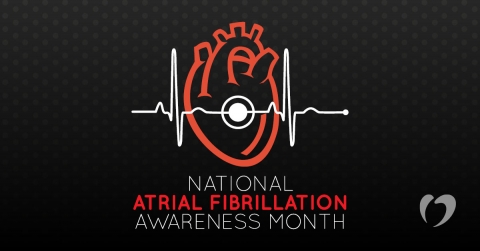September is National Atrial Fibrillation Awareness Month

In September we recognize National Atrial Fibrillation Awareness Month. Atrial Fibrillation (AF or AFib) is the most common heart rhythm disorder. Millions of Americans live with AFib, and not all of them know they have it. Some may not have any symptoms, while others may have mild symptoms but are undiagnosed. For some, AFib only happens occasionally, but for others it is chronic.
What is atrial fibrillation?
AFib is a condition where your heart’s upper chambers beat out of sync with the lower chambers. This creates an abnormal heartbeat that is often rapid but can also be too slow or irregular.
Symptoms that a person may experience include:
- Irregular heartbeat
- Heart palpitations (skipped beats)
- Shortness of breath
- Fatigue
- Weakness
AFib puts you at increased risk for heart failure because of the extra strain on your heart and for blood clots. Because the heart beats out of sync, blood doesn’t flow through the heart as well as it should, which can lead to pooling and the formation of blood clots. If a clot dislodges, it can travel to other parts of the body and block blood flow. When blood flow to the brain is blocked, it can cause a stroke.
Who is at risk?
Those who are most at risk for AFib include people with a family history of atrial fibrillation, existing heart disease, high blood pressure, obesity, or other chronic conditions including thyroid problems, sleep apnea, diabetes, chronic kidney disease, or lung disease.
What are the treatment options?
The goals for treatment include reducing the risk of stroke and correcting the abnormal heart rhythm. There are several treatment options for AFib, and your doctor will recommend a treatment based on factors including how long you’ve had atrial fibrillation and the frequency of symptoms. Often, medication is the first line of treatment. Antiarrhythmic medications that control heart rhythms may be enough to treat AFib, and blood thinners may be prescribed to reduce the risk of blood clots.
If medication alone does not correct or control the heart rhythm, there are surgeries and procedures your doctor may recommend. Sometimes a cardioversion procedure is used to shock your heart and reset the heart’s normal rhythm. Depending on the cause of the AFib, your doctor may choose a catheter ablation. During a catheter ablation, a long, thin tube (catheter) is inserted in your blood vessels near your groin, then fed up to the heart. Using the tip of the catheter, the doctor can remove or destroy the tissue in the heart that is causing the irregular heartbeat.
Overall, AFib is a very treatable condition. If you are experiencing symptoms that may be atrial fibrillation, contact the doctors at Oklahoma Heart Hospital to schedule an appointment to find out more.




